dashboard Hyundai Santa Fe Sport 2017 Owner's Manual
[x] Cancel search | Manufacturer: HYUNDAI, Model Year: 2017, Model line: Santa Fe Sport, Model: Hyundai Santa Fe Sport 2017Pages: 614, PDF Size: 18.99 MB
Page 77 of 614
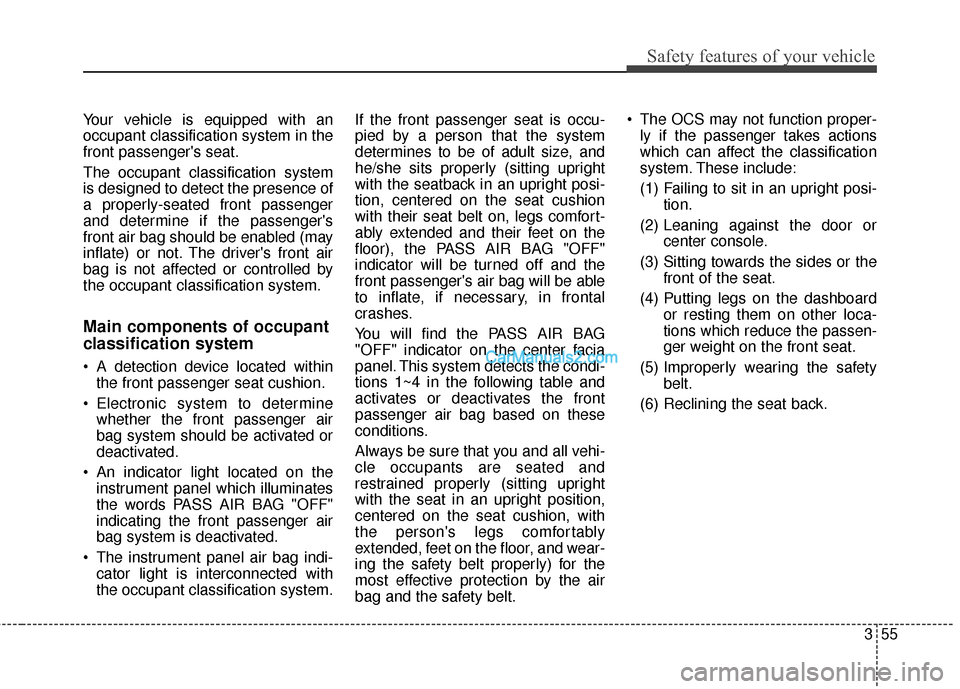
355
Safety features of your vehicle
Your vehicle is equipped with an
occupant classification system in the
front passenger's seat.
The occupant classification system
is designed to detect the presence of
a properly-seated front passenger
and determine if the passenger's
front air bag should be enabled (may
inflate) or not. The driver's front air
bag is not affected or controlled by
the occupant classification system.
Main components of occupant
classification system
A detection device located withinthe front passenger seat cushion.
Electronic system to determine whether the front passenger air
bag system should be activated or
deactivated.
An indicator light located on the instrument panel which illuminates
the words PASS AIR BAG "OFF"
indicating the front passenger air
bag system is deactivated.
The instrument panel air bag indi- cator light is interconnected with
the occupant classification system. If the front passenger seat is occu-
pied by a person that the system
determines to be of adult size, and
he/she sits properly (sitting upright
with the seatback in an upright posi-
tion, centered on the seat cushion
with their seat belt on, legs comfort-
ably extended and their feet on the
floor), the PASS AIR BAG "OFF"
indicator will be turned off and the
front passenger's air bag will be able
to inflate, if necessary, in frontal
crashes.
You will find the PASS AIR BAG
"OFF" indicator on the center facia
panel. This system detects the condi-
tions 1~4 in the following table and
activates or deactivates the front
passenger air bag based on these
conditions.
Always be sure that you and all vehi-
cle occupants are seated and
restrained properly (sitting upright
with the seat in an upright position,
centered on the seat cushion, with
the person's legs comfortably
extended, feet on the floor, and wear-
ing the safety belt properly) for the
most effective protection by the air
bag and the safety belt. The OCS may not function proper-
ly if the passenger takes actions
which can affect the classification
system. These include:
(1) Failing to sit in an upright posi- tion.
(2) Leaning against the door or center console.
(3) Sitting towards the sides or the front of the seat.
(4) Putting legs on the dashboard or resting them on other loca-
tions which reduce the passen-
ger weight on the front seat.
(5) Improperly wearing the safety belt.
(6) Reclining the seat back.
Page 232 of 614
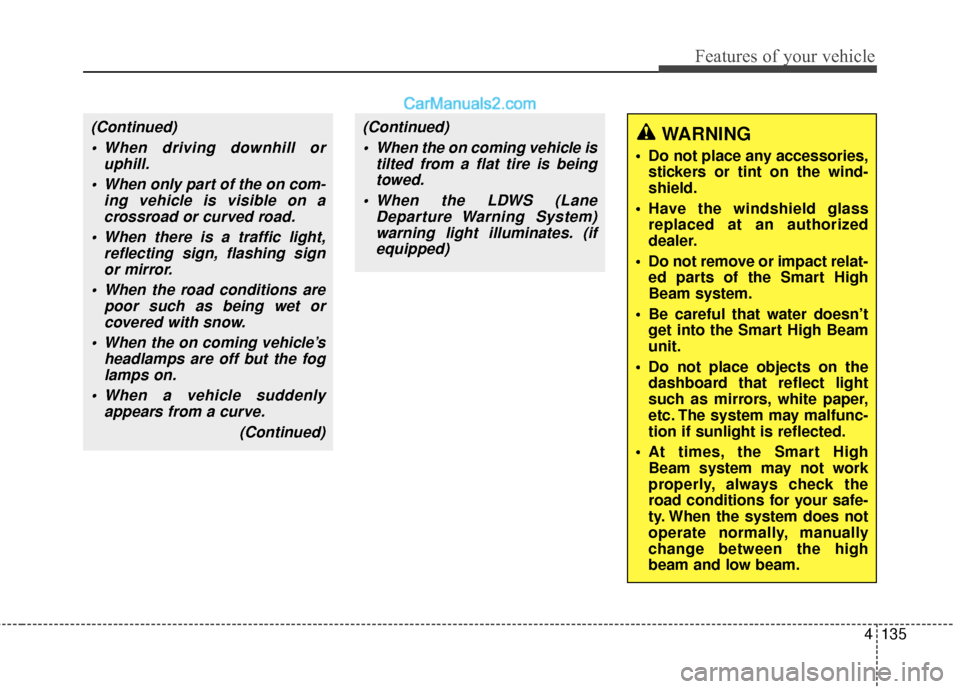
4135
Features of your vehicle
(Continued) When driving downhill or uphill.
When only part of the on com- ing vehicle is visible on acrossroad or curved road.
When there is a traffic light, reflecting sign, flashing signor mirror.
When the road conditions are poor such as being wet orcovered with snow.
When the on coming vehicle’s headlamps are off but the foglamps on.
When a vehicle suddenly appears from a curve.
(Continued)(Continued) When the on coming vehicle is tilted from a flat tire is beingtowed.
When the LDWS (Lane Departure Warning System)warning light illuminates. (ifequipped)WARNING
Do not place any accessories, stickers or tint on the wind-
shield.
Have the windshield glass replaced at an authorized
dealer.
Do not remove or impact relat- ed parts of the Smart High
Beam system.
Be careful that water doesn’t get into the Smart High Beam
unit.
Do not place objects on the dashboard that reflect light
such as mirrors, white paper,
etc. The system may malfunc-
tion if sunlight is reflected.
At times, the Smart High Beam system may not work
properly, always check the
road conditions for your safe-
ty. When the system does not
operate normally, manually
change between the high
beam and low beam.
Page 279 of 614

Features of your vehicle
182
4
✽
✽
NOTICE
• If you install an aftermarket HID
headlamp, your vehicle's audio
and electronic device may mal-
function.
• Prevent caustic solutions such as perfume and cosmetic oil from
contacting the dashboard because
they may cause damage or discol-
oration.
Antenna
Roof antenna
Your vehicle uses a roof antenna to
receive both AM and FM broadcast
signals.
Steering wheel audio control
The steering wheel incorporates
audio control buttons on the left hand
side of the steering wheel.
AUDIO SYSTEM
OANNMM2901
CAUTION
Do not operate audio remote
control buttons simultaneously.
ODM042327
Page 440 of 614
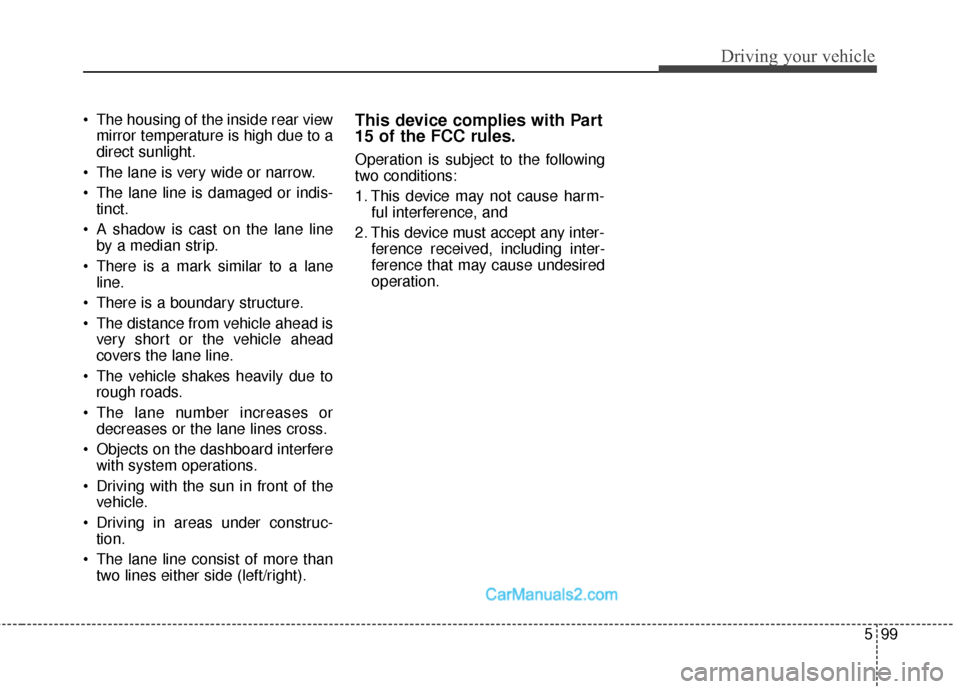
599
Driving your vehicle
The housing of the inside rear viewmirror temperature is high due to a
direct sunlight.
The lane is very wide or narrow.
The lane line is damaged or indis- tinct.
A shadow is cast on the lane line by a median strip.
There is a mark similar to a lane line.
There is a boundary structure.
The distance from vehicle ahead is very short or the vehicle ahead
covers the lane line.
The vehicle shakes heavily due to rough roads.
The lane number increases or decreases or the lane lines cross.
Objects on the dashboard interfere with system operations.
Driving with the sun in front of the vehicle.
Driving in areas under construc- tion.
The lane line consist of more than two lines either side (left/right).This device complies with Part
15 of the FCC rules.
Operation is subject to the following
two conditions:
1. This device may not cause harm- ful interference, and
2. This device must accept any inter- ference received, including inter-
ference that may cause undesired
operation.
Page 584 of 614
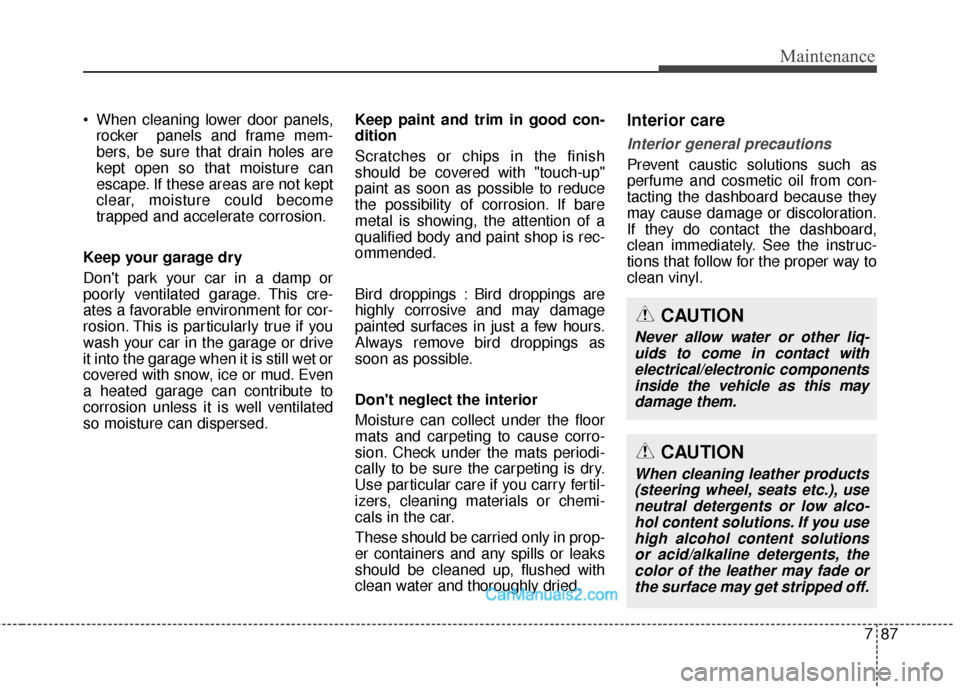
787
Maintenance
When cleaning lower door panels,rocker panels and frame mem-
bers, be sure that drain holes are
kept open so that moisture can
escape. If these areas are not kept
clear, moisture could become
trapped and accelerate corrosion.
Keep your garage dry
Don't park your car in a damp or
poorly ventilated garage. This cre-
ates a favorable environment for cor-
rosion. This is particularly true if you
wash your car in the garage or drive
it into the garage when it is still wet or
covered with snow, ice or mud. Even
a heated garage can contribute to
corrosion unless it is well ventilated
so moisture can dispersed. Keep paint and trim in good con-
dition
Scratches or chips in the finish
should be covered with "touch-up"
paint as soon as possible to reduce
the possibility of corrosion. If bare
metal is showing, the attention of a
qualified body and paint shop is rec-
ommended.
Bird droppings : Bird droppings are
highly corrosive and may damage
painted surfaces in just a few hours.
Always remove bird droppings as
soon as possible.
Don't neglect the interior
Moisture can collect under the floor
mats and carpeting to cause corro-
sion. Check under the mats periodi-
cally to be sure the carpeting is dry.
Use particular care if you carry fertil-
izers, cleaning materials or chemi-
cals in the car.
These should be carried only in prop-
er containers and any spills or leaks
should be cleaned up, flushed with
clean water and thoroughly dried.Interior care
Interior general precautions
Prevent caustic solutions such as
perfume and cosmetic oil from con-
tacting the dashboard because they
may cause damage or discoloration.
If they do contact the dashboard,
clean immediately. See the instruc-
tions that follow for the proper way to
clean vinyl.
CAUTION
Never allow water or other liq-
uids to come in contact withelectrical/electronic componentsinside the vehicle as this maydamage them.
CAUTION
When cleaning leather products(steering wheel, seats etc.), useneutral detergents or low alco-hol content solutions. If you usehigh alcohol content solutionsor acid/alkaline detergents, thecolor of the leather may fade orthe surface may get stripped off.
Page 599 of 614
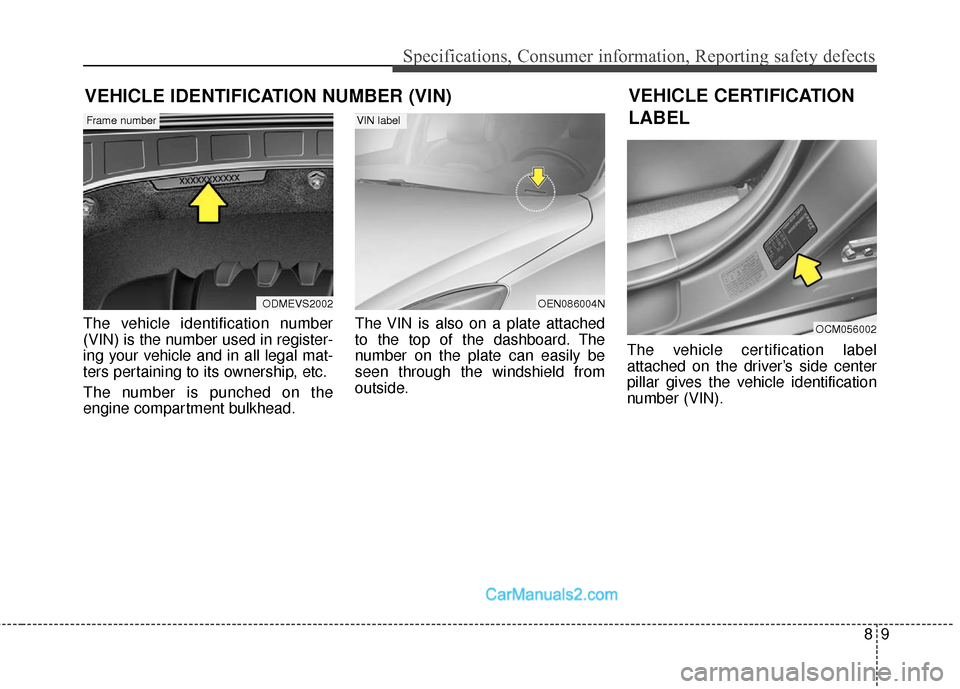
89
Specifications, Consumer information, Reporting safety defects
The vehicle identification number
(VIN) is the number used in register-
ing your vehicle and in all legal mat-
ters pertaining to its ownership, etc.
The number is punched on the
engine compartment bulkhead.The VIN is also on a plate attached
to the top of the dashboard. The
number on the plate can easily be
seen through the windshield from
outside.
The vehicle certification label
attached on the driver’s side center
pillar gives the vehicle identification
number (VIN).
VEHICLE IDENTIFICATION NUMBER (VIN)
ODMEVS2002
Frame number
VEHICLE CERTIFICATION
LABEL
OEN086004N
VIN label
OCM056002
Page 606 of 614
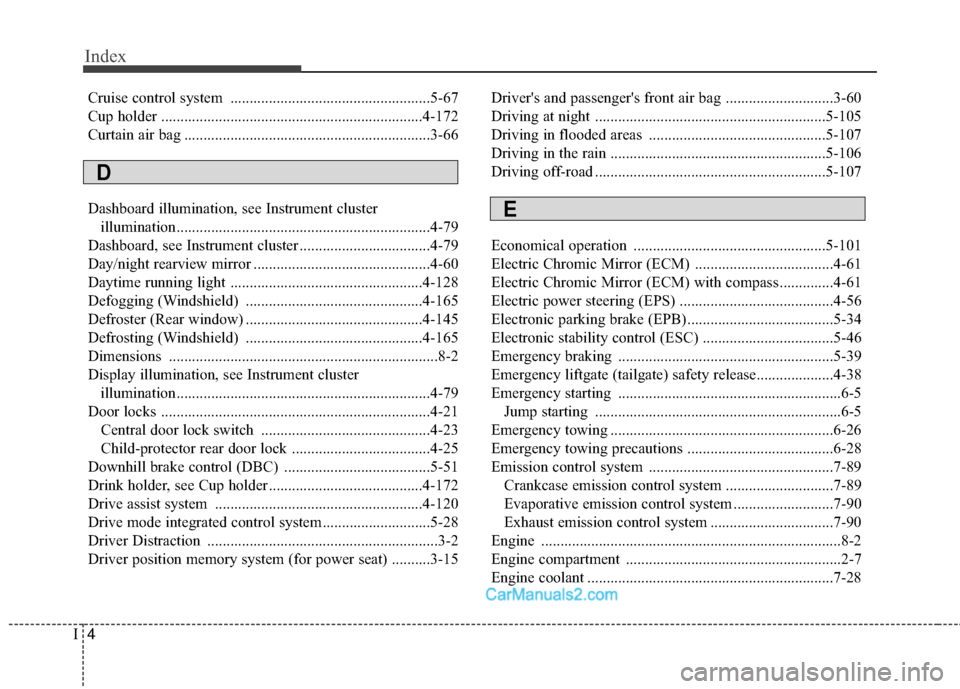
Index
4I
Cruise control system ....................................................5-67
Cup holder ....................................................................4-17\
2
Curtain air bag ................................................................3-66
Dashboard illumination, see Instrument cluster illumination..................................................................4-79
Dashboard, see Instrument cluster ..................................4-79
Day/night rearview mirror ..............................................4-60
Daytime running light ..................................................4-128
Defogging (Windshield) ..............................................4-165
Defroster (Rear window) ..............................................4-145
Defrosting (Windshield) ..............................................4-165
Dimensions ......................................................................8-\
2
Display illumination, see Instrument cluster illumination..................................................................4-79
Door locks ......................................................................4-\
21 Central door lock switch ............................................4-23
Child-protector rear door lock ....................................4-25
Downhill brake control (DBC) ......................................5-51
Drink holder, see Cup holder ........................................4-172
Drive assist system ......................................................4-120
Drive mode integrated control system ............................5-28
Driver Distraction ............................................................3-2
Driver position memory system (for power seat) ..........3-15 Driver's and passenger's front air bag ............................3-60
Driving at night ............................................................5-105
Driving in flooded areas ..............................................5-107
Driving in the rain ........................................................5-106
Driving off-road ............................................................5-107
Economical operation ..................................................5-101
Electric Chromic Mirror (ECM) ....................................4-61
Electric Chromic Mirror (ECM) with compass ..............4-61
Electric power steering (EPS) ........................................4-56
Electronic parking brake (EPB) ......................................5-34
Electronic stability control (ESC) ..................................5-46
Emergency braking ........................................................5-39
Emergency liftgate (tailgate) safety release....................4-38
Emergency starting ..........................................................6-5
Jump starting ................................................................6-5
Emergency towing ..........................................................6-26
Emergency towing precautions ......................................6-28
Emission control system ................................................7-89 Crankcase emission control system ............................7-89
Evaporative emission control system ..........................7-90
Exhaust emission control system ................................7-90
Engine ........................................................................\
......8-2
Engine compartment ........................................................2-7
Engine coolant ................................................................7-28
D
E